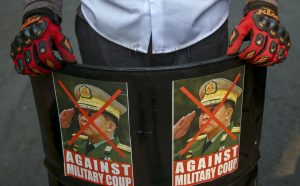Thomas Kean

The small protest in the central Myanmar town of Pyin Oo Lwin on January 16 was far less spectacular than the military’s recent battlefield losses, but for dictator-in-chief Min Aung Hlaing it was possibly just as damaging. Rather than call for the end of the junta that seized power in a February 2021 coup – as millions across Myanmar have done over the past three years – the pro-regime protesters urged Min Aung Hlaing to step down as head of the military, and hand over power to his deputy, Soe Win.
“Look at Soe Win’s face,” the nationalist monk Pauk Ko Taw told the crowd of a few hundred people. “That’s the face of a real soldier. Min Aung Hlaing is not coping. He should move to a civilian role.”
A former colonial hill station, Pyin Oo Lwin occupies a strategic location on the edge of the Shan plateau astride the main highway to China. It is also of great operational, symbolic, and emotional importance to the military, hosting not only its elite Defense Services Academy and other training institutes but also many retired officers, who live in new suburbs colloquially referred to as bogyoke ywar (“village of generals”).
Security is relatively tight; Pyin Oo Lwin is one of the few places in Myanmar where pro-regime types can move around without having to watch nervously for resistance hit squads. Although no military personnel are known to have taken part in the protest, it is unlikely to have been possible without at least some tacit support from within the regime’s own ranks.
There was little dissent on display when the military-controlled National Defense and Security Council met on January 31 – just ahead of the third anniversary of the coup – and formally agreed to Min Aung Hlaing’s proposal to extend military rule for a further six months. But behind this pro forma show of unity lies real and growing discontent with Min Aung Hlaing’s leadership.
The military is arguably in its weakest position since the 1950s, when by some reports it controlled barely a quarter of the country. Insiders say that senior officers openly curse Min Aung Hlaing behind his back, mocking his detached-from-reality public pronouncements, his micromanaging style, and his naked political ambitions.
This growing anger may explain some of the leniency shown to the organizer of the Pyin Oo Lwin protest, Pauk Ko Taw, who was detained for questioning but later released. It contrasts with the punishment meted out just months earlier to another prominent Min Aung Hlaing critic within the military establishment. In November, Ye Htut, a former military officer who served as minister for information and presidential spokesman under Thein Sein in the mid-2010s, was sentenced to 10 years in prison for seditious posts on Facebook. Ye Htut was arrested on October 28, a week after he hit publish on an allegorical post about an arrogant buffalo at Inle Lake that was standing triumphantly on a pile of trash, but didn’t realize it was surrounded by water.
At the time, Min Aung Hlaing had just been forced into sacking and jailing some of his closest allies in the regime’s upper ranks for their role in a colossal corruption scandal that had seen them misuse the regime’s precious foreign currency reserves for personal gain. It had seemed like a nadir for the regime, but far worse was to come – this time on the perennial battlefield of northern Shan State, which had been unusually quiet since the coup.
No comments:
Post a Comment